|
Important Note!
Some of these sequences were photographed decades ago before we participated in a helmet safety study. The results of the study were impressively conclusive. Since 1998 we always wear approved helmets when training and handling horses.
Wild horses that go through BLM processing are pretty familiar with fences. For one thing, they learn that if they are on one side of a fence and the human is on the other, the fence provides a significant measure of safety, much the same as we may regard a large lion behind bars. Maybe we don't want to
get too cozy, but it's OK so long as the bars separate us. The wild horse also figures out pretty fast that the opposite logic applies when the human is locked inside the pen with him. Therefore just entering the pen can generate a significant amount of stress. With some horses, simply entering the pen
and immediately engaging the horse can evoke a sure-fire flight response, and in some rare instances, the handler being charged by the horse.
We start out with what we call "the quiet hour." For the first hour we don't try any "pursuit" movements or try to dominate the horse. While we might actually get our hands on the horse, we need to first condition his response to our presence and generate some trust before we start playing "Who's the Boss."
OBJECTIVE: Make the horse comfortable with nearby human activities
|
Typically I will enter the pen and just hang out at the far side for a minute or two until the horse has sized me up. Then I'll move around in a natural manner, "investigating" a fence panel, manure piles and any other objects of interest. If the horse faces up to me, I'll relax and lower my head with knees slightly bent for a few seconds, looking past (not directly at) the horse. Then I'll move away.
My movements will often take the shape of an oval moving in the same direction that the horse is headed. For example, if the horse is facing to my right, I will move in a clockwise direction. This way I can see the loaded end of the
horse on my approach. If he shows any sign of saucy behavior towards me, I'll stomp a foot, give a hard shake of my head and gesture him away with my hands. After he is once again quiet I will continue making my ovals.
|
Exaggerating "relaxed" posture
when the horse checks me out
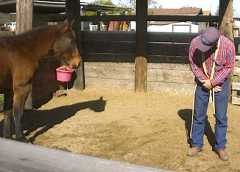
| |
As the minutes progress, I'll get closer and closer to the horse. The ovals are shaped so that I don't get within kicking range and my oval comes closest to the horse's shoulder. Each time I pass the shoulder I'll scribe a small line in the dirt with the outside edge of my boot, not breaking stride and avoiding looking aggressive when I do this. As soon as I reach a point of closeness that the horse shifts his weight at my approach, I'll withdraw to the far side of the pen and climb out. Given a couple of moments alone, most horses will swing around and smell my "scratch" marks. This is a good sign.
| |
When I reenter the pen I'll start moving my arms about, maybe sing the Mr. Ed song and do other "normal" human stuff. I want the horse to get accustomed to my movements and actions while close to him but I'm really careful about not directing any energy toward the horse as that may send him off. I increase the intensity if my movements only when I'm walking away from the horse. (Perhaps singing the Mr. Ed song is not all that "normal." The point is for us to engage in some activity that will make us less likely to behave predator-like.)
A couple of times I will quietly approach more directly from behind and from a safe distance toss my head upwards and toward the horse like the lead mare, and I'll ask him to walk forward about halfway around the pen. When he responds I'll go back to a neutral location and let him find his comfort spot.
Once I see he's OK with all this stuff I'm showing him, I'll start swinging ropes all around, again making sure I don't direct energy at him but simply generating movement that he can get accustomed to. Within a few minutes I should be able to swing a rope as hard as I can. So long as the horse is not directed at the horse, he should stand quietly.
|
Flapping my arms like a bird
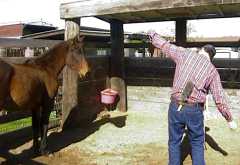
Twirling the rope over the
horse's head
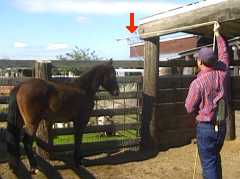
|
|
Once the horse tolerates the rope, I'll bring in a bamboo pole and let him
get used to it in the same manner. As I get closer I'll pass the pole over the horse. If he reacts I'll stop and let him check it out. Usually placing the pole on the ground in front of him will prompt a curious response. I'll give him as long
as he wants to explore it.
After the horse is OK with my waving the pole about, he has investigated it and knows what it is all about, I'll start preparing him to be rubbed by the pole. This process involves gradually adjusting the movement of the pole from simply rotating it above the horse to tracing his silhouette from front to back, starting some distance from the horse and eventually scribing the trace within a couple of inches from his body.
When the horse is settled to having the pole moving that closely, he's ready to be touched.
|
Checking out the pole
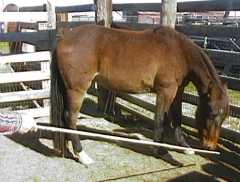
Tracing the horse with the pole
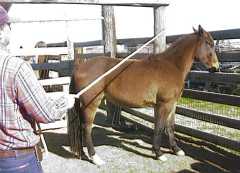
| |
In Part Three of this feature we will discuss "grooming" the horse with the pole.
|
Press "Back" to return to the page which brought you here
KBR Horse Training Information, © 1997 Lamm's Kickin' Back
Ranch and Willis & Sharon Lamm. All rights reserved. Duplication of any of this material for
commercial use is prohibited without express written permission. This prohibition is
not intended to extend to personal non-commercial use, including sharing with others for
safety and learning purposes, provided this copyright notice is attached.
Email us to submit comments or request reproduction
permission.
|





